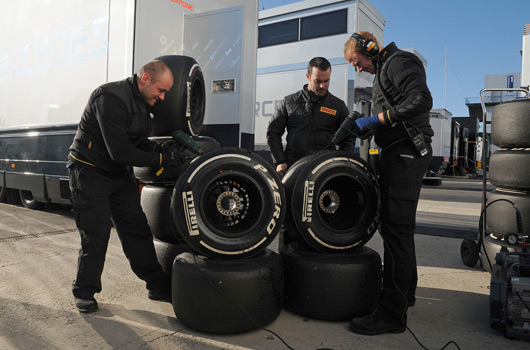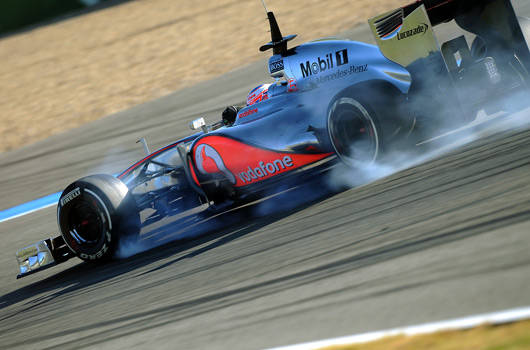Pirelli has kindly gathered a bunch of stats from the recent F1 testing in Jerez that offers a valuable insight into their role as tyre supplier. For the conservationists reading, you might want to look away now.
Over the four days of testing 23 drivers completed almost 15,000 kilometres and used a total of 724 tyres. From Pirelli’s point of view they were eager to learn if their new tyres would better retain their performance for longer periods.
Pirelli’s motorsport director Paul Hembery said: “The tyres performed exactly in line with our expectations here in Jerez, and we’ve had a very positive reaction from the drivers and teams so far, who have reported more grip at the rear, fewer ‘marbles’ and a reduced lap time difference between the compounds as well as faster overall performance – which is precisely what we wanted.
“We’re happy with the level of degradation and we had no issues, as was the case for all of last year. But as the temperatures in Jerez were very low and the teams have also concentrated on other areas than tyres, it’s too early to draw any detailed conclusions.”
Pirelli will continue the learning process when testing resumes at Barcelona next week (21–24 February).
[Pics: Pirelli Media]
Pirelli Tyres Complete 14,949 Kilometres in Four Days of Testing
Pirelli supplied 1176 tyres for the first Formula One test of the 2012 season, held at the Jerez circuit in the south of Spain over four days. A total of 3380 laps were covered by 23 drivers – equating to 14,949 kilometres.
The new P Zero White medium tyre completed the most running in Spain with 1776 laps run (91 sets used), followed by the new P Zero Yellow soft with 1010 laps run (57 sets used) and the P Zero Silver hard with 594 laps run (33 sets used). Although the new Pirelli Cinturato Green intermediate tyre and Pirelli Cinturato Blue tyre was brought to Spain, it was not used as the weather stayed dry despite ambient temperatures that dipped to as low as -2 °C degrees centigrade.
The 2012 tyres performed in line with expectations at Jerez, but with most teams running brand new cars in different phases of development, it was hard to draw firm conclusions about relative performance.
Pirelli’s motorsport director Paul Hembery said: “The tyres performed exactly in line with our expectations here in Jerez, and we’ve had a very positive reaction from the drivers and teams so far, who have reported more grip at the rear, fewer ‘marbles’ and a reduced lap time difference between the compounds as well as faster overall performance – which is precisely what we wanted. We’re happy with the level of degradation and we had no issues, as was the case for all of last year. But as the temperatures in Jerez were very low and the teams have also concentrated on other areas than tyres, it’s too early to draw any detailed conclusions. We’ll see more tyre development work at the next test in Barcelona, as together with the teams, we fully understand the implications of the latest rules. However, with all three of our available slick tyres having set a fastest time, it’s a clear sign that we are on course to meet our objectives.â€
Lotus driver Kimi Räikkonen – who last drove on Pirelli tyres in the 2010 World Rally Championship – set the pace on the opening day, with a spectacular return to Formula One thanks to a time of 1m19.670s on the P Zero White medium tyre.
Mercedes were quickest on the second and third days using their 2011 car. Michael Schumacher lowered the benchmark to 1m18.561s on day two with the P Zero Silver hard tyre and Nico Rosberg set a time of 1m17.631s on day three with the P Zero Yellow soft: the best time over all four days.
The Jerez test ended with Ferrari’s Fernando Alonso going quickest with a time of 1m18.877s on the final day, again using the soft tyre.
Testing Facts:
- During comparison runs between the new medium and the new hard tyre on day one, there was a difference of between 0.4-0.5 seconds, with better grip and less wear: particularly at the rear.
- The driver to complete the most laps at Jerez was Kimi Räikkonen, who racked up 192 laps on the soft, medium and hard over the first two days: nearly the equivalent of three grands prix.
- Most teams started off with short runs initially, before trying longer runs and race simulations for the first time as they expanded their development programmes.
- The top times on all four days comfortably beat the benchmark established at the last test in Jerez one year ago, where Rubens Barrichello went fastest for Williams with a time of 1m19.832s.
Testing numbers:
- Total number of sets brought to Jerez: 294 sets which equals 1176 tyres
- Of which soft tyres: 71 sets
- Of which Medium tyres: 105 sets
- Of which Hard tyres: 43 sets
- Of which Intermediate tyres: 38 sets
- Of which Wet tyres: 37 sets
- Total amount of sets used: 181
- Of which soft tyres: 57 sets
- Of which Medium tyres: 91 sets
- Of which Hard tyres: 33 sets
- Of which Intermediate tyres: 0 sets
- Of which Wet tyres: 0 sets
- Longest run: 26 laps on the hard compound, 27 laps of the medium compound, 20 laps on the soft compound
- Highest / lowest ambient temperature over four days: 20 °C / -2 °C
- Highest / lowest track temperature over four days: 26 °C / 0 °C
Tyre Summary:
Day 1
1. Räikkönen – 1’19″670 on Medium New
2. Di Resta – 1’19″772 on Medium New
3. Rosberg – 1’20″219 on Soft New
Day 2
1. Schumacher – 1’18’’561 on Hard New
2. Webber – 1’19’’184 on Soft New
3. Ricciardo – 1’19’’587 on Soft New
Day 3
1. Rosberg – 1’17’’631 on Soft New
2. Räikkönen – 1’18’’419 on Medium New
3. Vettel – 1’19’’297 on Soft New
Day 4
1. Alonso – 1’18″877 on Soft New
2. Vergne – 1’19″597 on Soft New
3. Vettel – 1’19″606 on Medium New

